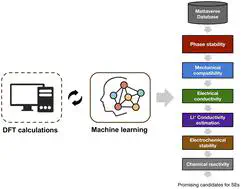Machine-learning assisted high-throughput discovery of solid-state electrolytes for Li-ion batteries
 Image credit: Unsplash
Image credit: UnsplashAbstract
The development of high-performance solid-state lithium-ion batteries (LIBs) requires designing solid-state electrolytes (SEs) with high ionic conductivity and excellent electrochemical stability. Here, we report 130 novel materials as promising SEs, identified through large-scale high-throughput calculations. These calculations employed a universal machine-learning interatomic potential (ML-IAP) as a surrogate model for density functional theory (DFT). In calculating the Li+ conductivity of well-known conductors, we found that the universal ML-IAP tends to underestimate the activation energy for Li+ conductivity by about 150 meV compared to DFT calculations. To identify practical SEs, we parameterized screening criteria for key material properties including synthesizability, interfacial stability, and ionic conductivity. We then established a tiered workflow for the accurate and efficient assessment of potential SEs. Additionally, we developed a tree-based ML model to unravel the relationship between structure, chemistry, and conductivity. Our findings indicate that features such as maximum packing efficiency, volume per atom, packing fraction, and differences in electronegativity are crucial in influencing Li+ conduction. This work not only introduces novel SEs vital for the advancement of solid-state LIBs but also showcases the potential of ML in material innovation.